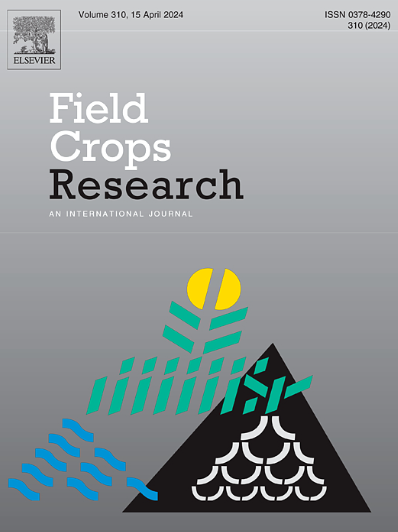Relevance of grain number and grain weight on barley yield responses to environmental and genetic factors
IF 5.6
1区 农林科学
Q1 AGRONOMY
引用次数: 0
Abstract
Context
Global food demand is projected to rise, making it essential to enhance agricultural production to ensure food security while minimizing environmental impacts, particularly in the face of climate change challenges. Understanding the determination of grain yield (GY) in barley is crucial for future advancements in this crop.
Objective
This study examines the relationships between the two major components of GY (grain number-GN and grain weight-GW), when driven by genetic and environmental factors.
Methods
We compiled data of GY and its numerical components (i.e. GN and GW) to generate a large and unbiased database from every single paper having the word “barley” in the title published over 25 years in four prestigious international journals: Field Crop Research, European Journal of Agronomy, Crop Science and Crop and Pasture Science (formerly Australian Journal of Agricultural Research) between January 1996 and December 2021, both inclusive.
Results
GN was significantly better correlated with GY than GW, accounting for 86 % of the variation in GY compared to just 13 % for GW. The changes in GY responsiveness to environmental and genetic factors were mainly due to variations in GN, especially in scenarios with high responsiveness. In contrast, low-responsiveness cases showed trade-offs between GN and GW, suggesting compensatory mechanisms that may not accurately reflect competition for resources.
Conclusions
The potential to increase barley GY relies heavily on GN, emphasizing the need to optimise conditions during the critical period of GN determination.
Implications
Barley crops under typical field conditions are generally not limited by resource availability during grain filling.
粒数和粒重与大麦产量对环境和遗传因素响应的相关性
预计全球粮食需求将增加,因此必须提高农业生产,以确保粮食安全,同时尽量减少对环境的影响,特别是在面临气候变化挑战的情况下。了解大麦籽粒产量(GY)的决定对该作物的未来发展至关重要。目的研究籽粒数(粒数)和粒重(粒重)在遗传和环境因素驱动下的关系。方法:我们收集了小麦产量及其数值组成部分(即GN和GW)的数据,从1996年1月至2021年12月期间在四个著名国际期刊(包括田间作物研究、欧洲农学杂志、作物科学和作物与牧场科学杂志)发表的25年中标题中含有“大麦”一词的每一篇论文中生成一个庞大且无偏差的数据库。结果gn与GY的相关性明显优于GW,占GY变化的86% %,而GW仅占13% %。GY对环境和遗传因素的响应性变化主要是由于GN的变化,特别是在高响应性的情况下。相比之下,低响应性案例显示了GN和GW之间的权衡,这表明补偿机制可能无法准确反映资源竞争。结论大麦谷氨酸的增加很大程度上依赖于谷氨酸氮,需要在谷氨酸氮测定的关键时期优化条件。在典型的田间条件下,大麦作物通常不受灌浆期间资源可用性的限制。
本文章由计算机程序翻译,如有差异,请以英文原文为准。
求助全文
约1分钟内获得全文
求助全文
来源期刊

Field Crops Research
农林科学-农艺学
CiteScore
9.60
自引率
12.10%
发文量
307
审稿时长
46 days
期刊介绍:
Field Crops Research is an international journal publishing scientific articles on:
√ experimental and modelling research at field, farm and landscape levels
on temperate and tropical crops and cropping systems,
with a focus on crop ecology and physiology, agronomy, and plant genetics and breeding.
 求助内容:
求助内容: 应助结果提醒方式:
应助结果提醒方式:


